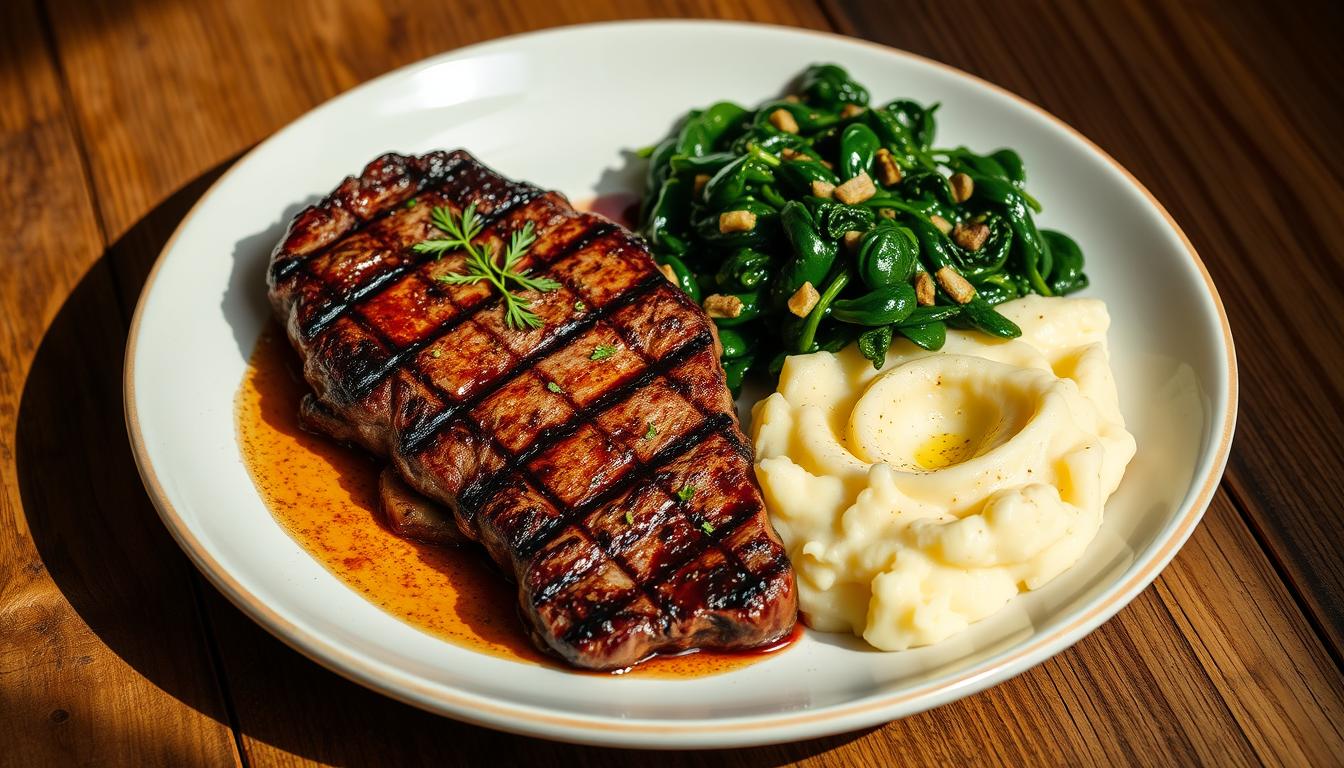Do you have endometriosis and find it hard to eat without making symptoms worse? This tasty endo-friendly steak and spinach recipe is here to help. It’s full of anti-inflammatory foods and meets the daily veggie goal of 6-9 cups. Adding this meal to your diet is a big step towards managing endometriosis and boosting your health.
Living with endometriosis can be tough, but the right food can make a big difference. This recipe, with grass-fed beef, spinach, and potatoes, is a great example. It’s not only delicious but also helps your body heal naturally.
Understanding Endometriosis and Diet
Endometriosis is a chronic condition where tissue like the uterine lining grows outside the uterus. It causes symptoms like pelvic pain, heavy periods, and infertility. Diet can play a big role in managing endometriosis and easing symptoms.
What is Endometriosis?
Endometriosis is a disorder where tissue like the uterine lining grows outside the uterus. This tissue thickens, breaks down, and bleeds with each menstrual cycle. But, it can’t leave the body, causing inflammation, scarring, and adhesions.
Dietary Approaches for Managing Endometriosis
To manage endometriosis symptoms, certain diets can help. These include:
- Low FODMAP diet: A diet low in fermentable carbohydrates (FODMAPs) can reduce digestive discomfort and inflammation.
- Anti-inflammatory diet: Eating foods rich in omega-3s, like fish, nuts, seeds, and olive oil, can help reduce inflammation and pain.
- Fiber-rich foods: Eating more fiber-rich foods like whole grains, fruits, and vegetables can help manage excess estrogen levels.
- Nutrient-dense foods: Ensuring enough nutrients like iron, zinc, and magnesium can support overall health and symptom management.
By adopting a diet rich in nutrients, individuals with endometriosis can manage their condition better. This can help alleviate their symptoms.
Benefits of Fiber-Rich Foods for Endometriosis
Eating enough fiber is key for those with endometriosis. Fiber helps bind and remove excess estrogen, which can make symptoms worse. Foods high in fiber like veggies, fruits, whole grains, and legumes also keep the gut healthy. This is vital for fighting inflammation linked to endometriosis.
A 2013 study found that eating more veggies and omega-3s can protect against endometriosis symptoms. On the other hand, red meat, trans fats, and coffee might worsen symptoms.
In 2015, a review suggested a diet rich in fruits, veggies, whole grains, and omega-3s could prevent endometriosis. The Office on Women’s Health also advises avoiding caffeine and alcohol to lower endometriosis risk.
| Fiber-Rich Foods | Potential Benefits for Endometriosis |
|---|---|
| Vegetables | Support healthy gut function and reduce inflammation |
| Fruits | Provide antioxidants and fiber to help manage estrogen levels |
| Whole Grains | Contain fiber and nutrients that may alleviate endometriosis symptoms |
| Legumes | Rich in fiber and may help regulate hormones and reduce inflammation |
Adding high fiber foods to your diet can boost your gut health. It may also help manage estrogen metabolism linked to endometriosis. Talk to a healthcare provider or registered dietitian for advice tailored to your needs.
Anti-Inflammatory Foods and Endometriosis Relief
Eating anti-inflammatory foods is a smart move for those with endometriosis. Omega-3 fatty acids are great for reducing inflammation. You can find them in fatty fish, walnuts, and flax seeds.
There are many other anti-inflammatory foods that can help. Berries, leafy greens, and turmeric are all good choices. They can help fight inflammation and ease endometriosis symptoms.
| Anti-Inflammatory Foods | Nutrients | Benefits for Endometriosis |
|---|---|---|
| Fatty fish (salmon, mackerel, sardines) | Omega-3 fatty acids | Reduce inflammation, ease pain |
| Walnuts, flax seeds | Omega-3 fatty acids | Reduce inflammation, ease pain |
| Berries (blueberries, raspberries, strawberries) | Antioxidants, polyphenols | Combat oxidative stress, reduce inflammation |
| Leafy greens (spinach, kale, collards) | Antioxidants, vitamins, minerals | Reduce inflammation, support immune function |
| Turmeric | Curcumin | Potent anti-inflammatory properties |
Adding these anti-inflammatory foods to your diet can help manage endometriosis symptoms. Focus on whole, nutrient-rich foods. This way, you can use nature’s power to fight inflammation and find relief.
The Role of Grass-Fed Beef in an Endo-Friendly Diet
For those with endometriosis, choosing the right foods is key. Grass-fed beef is a great choice. It has more nutrients than regular beef, which can help with symptoms and health.
Nutrients in Grass-Fed Beef
Grass-fed beef is packed with iron and zinc. These minerals help fight inflammation and support health. It also has more omega-3 fatty acids than regular beef. These acids are known for their anti-inflammatory effects, which can ease endometriosis symptoms.
Grass-fed beef is also more nutrient-dense. This means it has more vitamins, minerals, and antioxidants. These can boost overall health and help manage endometriosis challenges.
Adding grass-fed beef to your diet can help your body heal naturally. It may also reduce endometriosis symptoms.
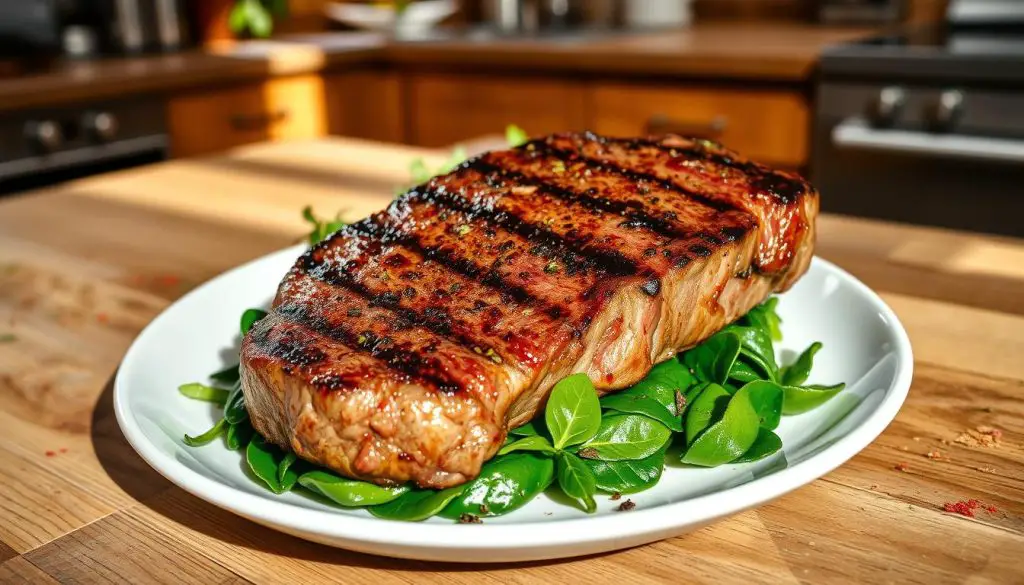
Spinach: A Nutrient-Dense Superfood for Endometriosis
For those with endometriosis, adding spinach to your diet can make a big difference. Spinach is a superfood, full of good stuff that helps with endometriosis symptoms. It also boosts your overall health.
Spinach is known for its high fiber content. Fiber helps with bowel movements and reduces inflammation. These are big issues for people with endometriosis. Plus, spinach has antioxidants like lutein and zeaxanthin. These fight off harmful free radicals and reduce inflammation.
Spinach is also packed with vitamins and minerals. It’s full of folate for cell growth and iron for healthy blood. Iron helps fight off fatigue too.
Adding spinach to your diet is a smart move for your health. It’s great in salads, sautéed, or in smoothies. Spinach is a superfood that can help manage endometriosis symptoms.
Endo friendly steak spinach potatoes
Finding good meals with endometriosis can be tough. But we’ve found a great solution. An endo-friendly steak, spinach, and potatoes dish is both tasty and helps with symptoms.
This meal mixes the taste of grass-fed steak with spinach’s nutrients and potatoes’ comfort. It’s a balanced dish that supports you on your endometriosis journey.
| Ingredient | Quantity |
|---|---|
| Grass-fed steak | 2-2.5 lbs, cubed |
| Baby spinach | 1 lb, washed |
| Potatoes | 3-4 medium, cubed |
| Olive oil | 2-3 tbsp |
| Salt and pepper | To taste |
The secret to this meal is its nutrient-rich ingredients. Grass-fed beef has omega-3s that fight inflammation. Spinach is full of vitamins and antioxidants. Potatoes offer complex carbs and fiber for energy.
Adding this dish to your diet nourishes your body. It helps manage endometriosis symptoms and supports your health. Enjoy this meal as part of your anti-inflammatory diet.
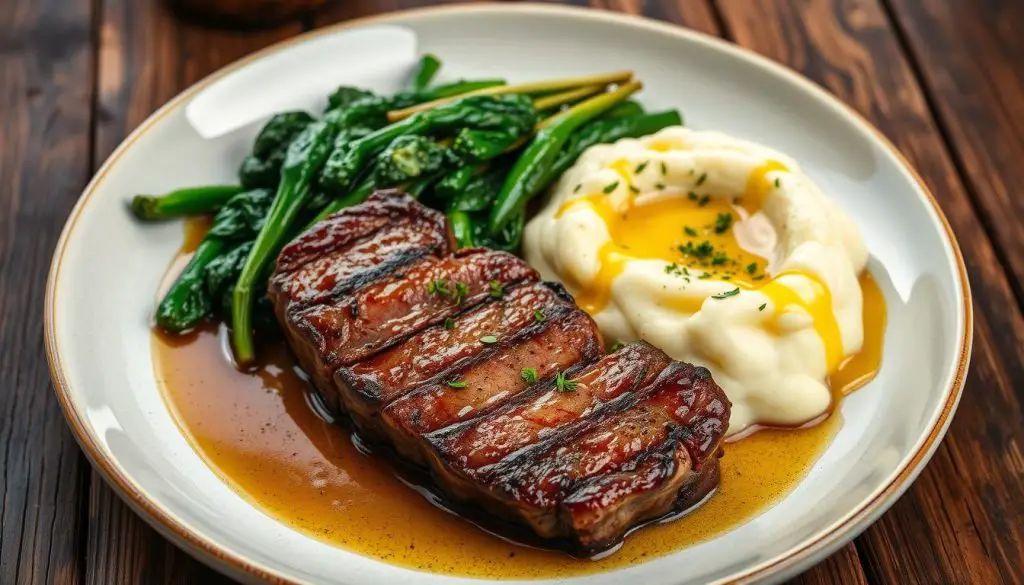
Preparing the Perfect Endo-Friendly Steak
Choosing the right steak is key for a tasty and healthy meal, even with endometriosis. We suggest picking grass-fed beef. It has more anti-inflammatory omega-3s and nutrients than regular beef. This guide will help you pick the best steak and cook it to boost nutrition for those with endometriosis.
Choosing the Right Cut of Steak
Choosing the right steak is the first step to a perfect endo-friendly meal. Here are some top picks:
- Flank steak – Lean, flavorful, and full of protein, it’s great for those with endometriosis.
- Sirloin tip – Tender, lean, and rich in zinc and iron, it’s a great choice for managing endometriosis.
- Filet mignon – A bit fattier, but tender and juicy, it’s a treat that’s also nutritious.
Make sure to choose grass-fed beef for the most health benefits in your endo-friendly diet.
Roasting Endo-Friendly Potatoes
Potatoes can be great for managing endometriosis. They are full of nutrients and can be made easy on your stomach. Roasting them is a favorite way to enjoy them.
Roasting brings out potatoes’ natural sweetness and keeps their nutrients. We use a low-FODMAP method to avoid ingredients that can upset the stomach. This makes our roasted potatoes good for your gut and full of vitamins and fiber.
- Choose small to medium-sized potatoes like Yukon Gold or red ones. They have less FODMAPs than bigger potatoes.
- Wash the potatoes well and cut them into small pieces. This helps them roast evenly.
- Put the potato pieces in a bowl and mix with olive oil, sea salt, black pepper, and herbs or spices for flavor.
- Put the seasoned potatoes on a baking sheet lined with parchment paper. This helps them get crispy without sticking.
- Roast the potatoes in a 400°F oven for 25-30 minutes, flipping them halfway. They should be golden brown and soft.
To get perfectly roasted potatoes, don’t overcrowd the baking sheet. Keep an eye on them as they cook. This way, they get a crispy outside and a soft inside, perfect with steak and spinach.
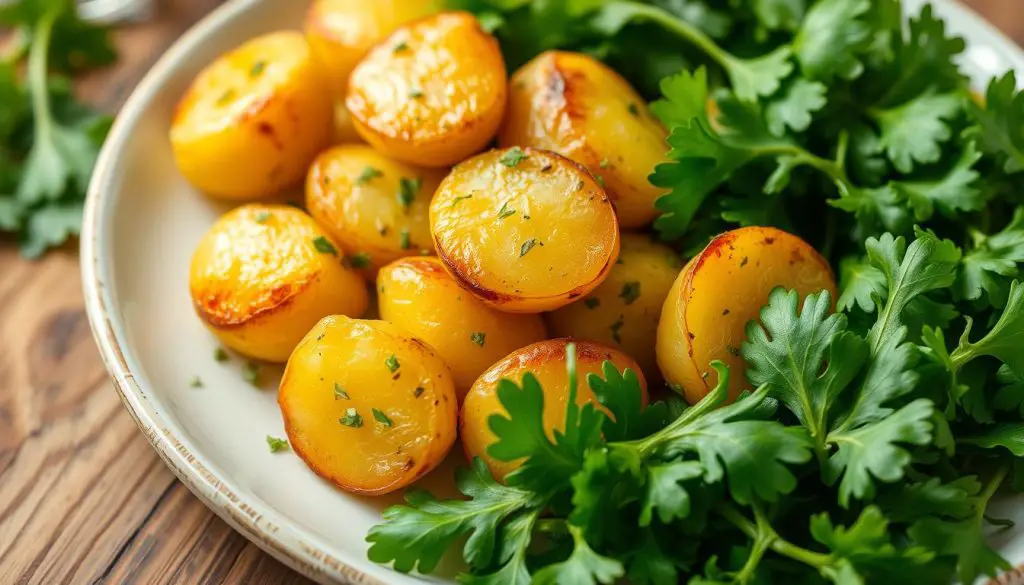
When your potatoes are done, serve them with steak and spinach. This makes a complete meal that’s good for your body and helps with endometriosis symptoms. Enjoy this tasty, endo-friendly dish as part of your low-FODMAP diet plan.
Sautéing Spinach for Maximum Nutrition
Spinach is packed with nutrients and is great for an endo-friendly diet. Sautéing is a top way to keep its vitamins and minerals intact. By following a few easy tips, we can make the most of sautéed spinach and add it to our steak and potato meal.
Tips for Cooking Spinach
To keep spinach’s nutrients when sautéing, follow these tips:
- Avoid overcooking: Spinach cooks fast, so don’t let it sit in the pan too long. Overcooked spinach loses its color and nutrients.
- Use minimal water: Use a little water or broth to steam the spinach. This keeps it moist and retains vitamins.
- Add spinach at the last minute: Add spinach towards the end to keep its texture and prevent overcooking.
- Season with care: Choose gentle seasonings like garlic, lemon, and a bit of healthy fat. They enhance spinach’s flavor without overpowering it.
By using these endo friendly cooking tips, we can preserve the nutrients in our sautéed spinach. This way, we can fully enjoy its benefits in our steak and potato meal.
Assembling the Endo-Friendly Steak Meal
We’ve got our ingredients ready – juicy grass-fed steak, spinach, and roasted potatoes. Now, let’s put them together for a tasty and good-looking meal. How we plate and assemble the meal can make a big difference. It can make our dining experience better and help us get the most from this healthy dish.
Begin by putting the seared steak in the middle of your plate. Put the sautéed spinach around it to add color and flavor. Then, place the roasted potatoes next to the steak. This way, all the flavors and textures can mix well together.
To make it even more appealing, you can sprinkle fresh herbs like parsley or thyme on the spinach. A bit of endo-friendly olive oil or lemon juice can also add a nice touch.
The goal is to highlight the natural tastes and health benefits of each ingredient. By layering them carefully, you’ll make a dish that looks great and is good for you. This can help with endometriosis symptoms.
| Step | Action |
|---|---|
| 1 | Place the seared steak at the center of the plate. |
| 2 | Arrange the sautéed spinach around the steak. |
| 3 | Position the roasted potatoes alongside the steak. |
| 4 | Optionally, garnish with fresh herbs or a drizzle of endo-friendly olive oil. |
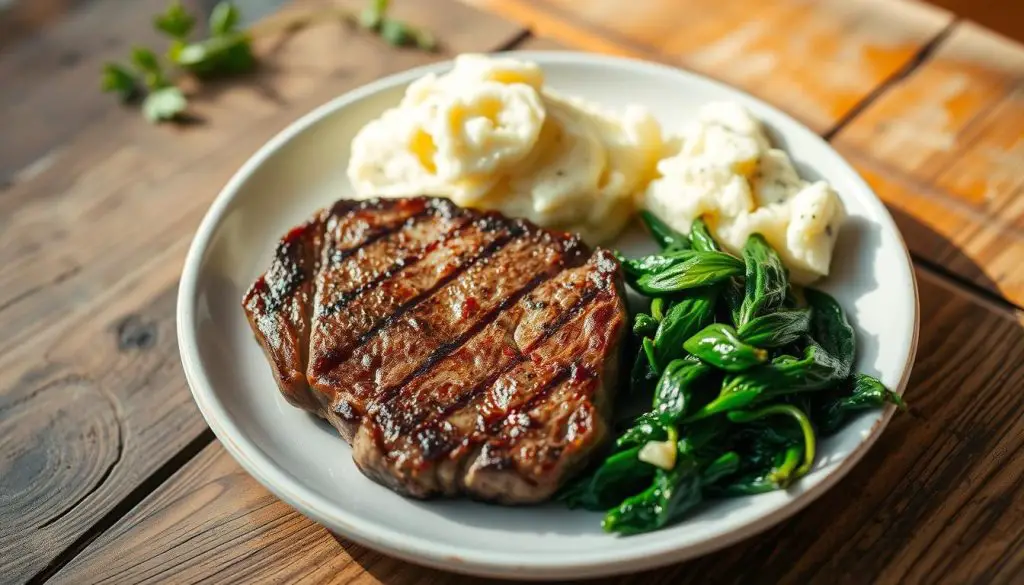
By following these easy steps, you can make a beautiful and healthy meal. This meal will not only taste great but also help your overall health.
Nutritious Side Dishes for Endometriosis Management
Enjoying the steak, spinach, and potato dish is great. But don’t forget to try endo friendly side dishes too. These anti-inflammatory sides and nutrient-dense accompaniments are tasty and good for you. They help ease your symptoms.
Try a roasted vegetable medley next. Mix colorful veggies like bell peppers, zucchini, onions, and Brussels sprouts. Drizzle with olive oil and roast until they’re tender and sweet. These veggies are full of fiber, antioxidants, and anti-inflammatory compounds. They’re great for your body.
Another great choice is a quinoa salad. It’s filled with cherry tomatoes, cucumber, feta cheese, and a zesty lemon vinaigrette. Quinoa is a nutrient-dense grain. It gives you energy, fiber, and important vitamins and minerals.
For dessert, make a chia pudding with honey or maple syrup. Chia seeds are full of omega-3 fatty acids. They help reduce inflammation. The pudding’s creamy texture is soothing and satisfying.
Adding these nutritious side dishes to your meals makes your meals better. They’re anti-inflammatory and nourish your body. A balanced diet is important for managing endometriosis well.
Meal Prep Tips for Endo-Friendly Eating
Preparing meals for endometriosis can be easier with meal prep and batch cooking. Spend a few hours each week planning and preparing meals. This way, you save time and always have healthy options ready.
Batch Cooking and Meal Planning
Batch cooking is a great way to make meal prep easier. Cook big batches of ingredients like steak, spinach, and potatoes all at once. This makes it easy to make meals for the week with little effort.
Meal planning is also key for endo-friendly eating. Spend time each week planning your meals with the ingredients you’ve cooked. This helps you stay on track with your diet and ensures you have a variety of healthy meals.
- Find your favorite endo-friendly recipes, like steak and spinach, and plan meals around them.
- Batch cook main ingredients like steak, spinach, and potatoes for easy meals.
- Make a weekly meal plan using your pre-cooked items for quick, healthy meals.
- Save time by chopping veggies or marinating proteins ahead of time.
Using these endo friendly meal prep, batch cooking, and meal planning tips can make mealtime easier. You’ll spend less time and effort on healthy, endo-friendly meals all week.
Modifying the Recipe for Your Dietary Needs
The steak, spinach, and potato recipe is endo friendly. But, we know everyone’s dietary needs are different. This recipe can be changed to fit various dietary restrictions and personalized nutrition needs.
For those who don’t eat meat, you can use grilled portobello mushrooms or tofu instead of steak. Adding more leafy greens, roasted veggies, or quinoa can make it even healthier.
If you need to avoid gluten or dairy, just replace potatoes with millet or buckwheat. Use a non-dairy milk or cheese when cooking the spinach.
| Dietary Restriction | Modification |
|---|---|
| Vegetarian/Vegan | Swap steak for grilled portobello mushrooms, tofu, or tempeh |
| Gluten-free | Use gluten-free grains like millet or buckwheat instead of potatoes |
| Dairy-free | Use dairy-free milk or cheese alternatives when sautéing spinach |
Always talk to a healthcare professional or a registered dietitian before changing your diet. They can help make sure you’re getting the right nutrients for your health and endometriosis symptoms.
By making smart changes to this recipe, you can enjoy a meal that’s both tasty and healthy. Try different ingredients to find the best mix for your body and endometriosis journey.
The Importance of a Balanced Diet for Endometriosis
Understanding endometriosis shows us how key a balanced diet is. It helps manage the condition. Endometriosis affects 176 million women worldwide, causing pain and infertility. A diet friendly for endometriosis can ease symptoms and boost health.
A good diet for endometriosis includes foods that fight inflammation and are rich in fiber and nutrients. Omega-3s in fatty fish, flaxseeds, and walnuts can reduce inflammation. Antioxidant fruits and veggies, like those on the “Clean Fifteen” list, also help manage symptoms.
It’s also important to avoid foods that might disrupt hormones, like some dairy and meat. Choosing organic, hormone-free options helps keep hormones balanced. A varied, nutrient-rich diet is a key step in managing endometriosis and improving life quality.
Source Links
- https://www.healendo.com/food-inspo
- https://chiavaye.com/blogs/endometriosis/endometriosis-diet-plan-recipes?srsltid=AfmBOopDheM-1cUFf-TcgrVHuhhFMFWI3pJfefeJO_dBqlNOluaK0cTV
- https://www.endofound.org/ready-to-grill-and-chill-try-these-endometriosis-friendly-bbq-recipes
- https://health.clevelandclinic.org/endometriosis-diet
- https://www.ssmhealth.com/SSMHealth/media/Documents/slucare/services/obstetrics-gynecology-womens-health/endometriosis-diet-booklet.pdf
- https://www.medicalnewstoday.com/articles/321471
- https://www.ncbi.nlm.nih.gov/pmc/articles/PMC8972862/
- https://www.efhou.org/post/feed-me-friday-the-endo-diet
- https://thedietologist.com.au/what-is-the-best-diet-for-adenomyosis/
- https://thyroidpharmacist.com/articles/best-diet-for-hashimotos-hypothyroidism/
- https://sofreshnsogreen.com/recipes/luteal-phase-foods/
- https://hertsandessexfertility.com/treatments/diet-for-health-egg-and-sperm/
- https://www.floliving.com/blog/?49d1e480_page=7
- https://www.everydayhealth.com/diet-nutrition/endomorph-diet/
- https://bebodywise.com/blog/foods-to-avoid-in-pcos/
- https://chiavaye.com/blogs/endometriosis/endometriosis-diet-plan-recipes?srsltid=AfmBOorS2dw-yIE-WEzy6bR4lfA3WllbbF7P1-lMEl1xX3IG0hA3XcgT
- https://healthunlocked.com/endometriosis-uk/posts/143148661/endometriosis-diet-meal-ideas-informative-post-add-yours-to-it-and-share
- https://chiavaye.com/blogs/endometriosis/endometriosis-diet-plan-recipes?srsltid=AfmBOop8NxcMG7ugUjRAJSc_f6VPO8NL5ahRyYJM9MT0ipkBbtAPwtSZ
- https://chiavaye.com/blogs/endometriosis/endometriosis-diet-plan-recipes?srsltid=AfmBOoqUtMunvjg5xrss3EL2mYSRZYul6rCWoUhiIc3Nr5YFNNir_se4
- https://www.everydayhealth.com/type-2-diabetes/diet/low-carb-veggies-for-diabetic-diets/
- https://www.nuvancehealth.org/health-tips-and-news/the-top-6-best-and-worst-fall-foods-for-heartburn
- https://www.fsnhp.msstate.edu/publications.php
- https://thedietologist.com.au/two-week-wait-diet/
- https://www.verywellhealth.com/endometriosis-diet-7105372
- https://chiavaye.com/blogs/endometriosis/endometriosis-diet-plan-recipes?srsltid=AfmBOorUSrMZ1Ep2DlWd6sCjL08dYgJOzhQyHpog_3EjDLatb6O4F6HU
- https://www.dailymail.co.uk/femail/article-11934799/I-use-ChatGPT-make-endometriosis-friendly-weekly-MEAL-PLAN.html
- https://www.barilife.com/blog/bariatric-friendly-restaurants/?srsltid=AfmBOoouiICRWaB0o7zrtX8mCbyiW9qdePyAb_S_tR1HhQIbQzZtLus9
- https://sofreshnsogreen.com/recipes/menstrual-phase-foods/
- https://www.everydayhealth.com/mediterranean-diet/complete-mediterranean-diet-food-list-day-meal-plan/
- https://www.medicalnewstoday.com/articles/322897
- http://www.hormonesmatter.com/eating-and-endometriosis/
- https://www.bswhealth.com/blog/endometriosis-diet-what-to-eat-if-you-have-endometriosis
